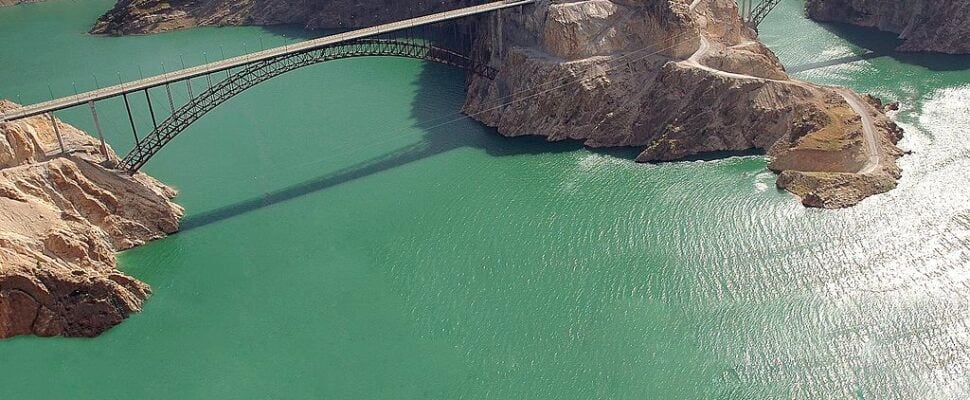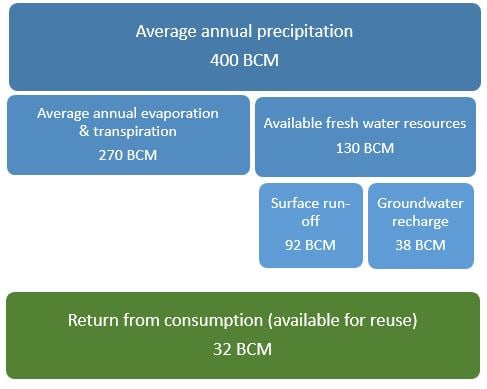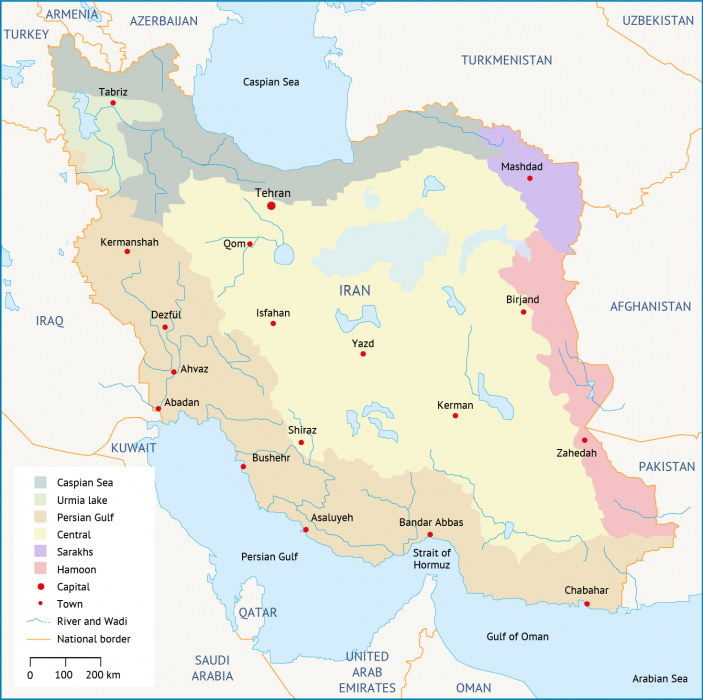
Water resources in Iran
Iran has several large rivers, but the only navigable one is the Karun river, the others being too steep and irregular. The Karun, with a total length of 890km, flows through the south-west of the country to the Shatt al-Arab, which is formed by the Euphrates and Tigris in Iraq after their confluence. The few streams that empty into the Central Plateau dissipate into the saline marshes. All streams are seasonable and variable. Spring floods do enormous damage, while there is little water flow in summer when most streams disappear. Water is, however, stored naturally underground, finding its outlet in subterranean water canals (qanats) and springs. It can also be tapped by wells.[1]
The average annual precipitation is estimated at 228mm, varying from 50mm in parts of the central water basin, to more than 1,500mm in some coastal areas near the Caspian Sea. 30% of precipitation occurs in the form of snow, and the rest falls as rainfall.[2] [3] The average annual precipitation is more than 830mm, classifying Iran as arid and semi-arid.[4]
Of the average annual rainfall volume of 406 billion cubic metres (BCM) [5], an estimated 68% evaporates before reaching the rivers. The total long-term annual renewable water resources are estimated at 120BCM,[6] of which about 78BCM go to surface run-off.
And groundwater recharge is estimated at about 45BCM per annum, 26% by qanats (underground water supply systems) and springs, and 74% by wells. The available per capita water is around 1,500m3, which is considerably less than the 7,000m3 per capita available in 1956.

Figure 1: Breakdown of freshwater availability in Iran. [7]
Iran is divided into six main and 31 secondary catchment areas. The six major basins are: the Central Plateau (Markazi) in the middle of the country (824,400km2), the Lake Urmia basin in the north-west (51,800km2), the Persian Gulf and the Gulf of Oman basin in the west and south (424,500km2), the Eastern Border basin in the east (known previously as Hamoon) (103,200km2), the Qareh Qum basin (known previously as Sarakhs) in the north-east (44,200km2), and the Caspian Sea basin in the north (Khazar, 174,000km2) (Map 2).[8] All these basins, except the Persian Gulf and the Gulf of Oman basin, are interior basins. Almost half of the country’s renewable water resources; are located in the Persian Gulf and the Gulf of Oman basin, which covers a fourth of the country.[9] By comparison, less than a third of the total renewable water resources are located in the Markazi basin, which covers over half of the country. With an area of 424,240km2, the Caspian Sea is the largest landlocked water body in the world and lies about 22 metres below sea level.

A)
B)
Figure 2: Iran’s major basins in 2016: a) Percentage of total area of the country (%)b) Percentage of total rainfall (%). [11]
Groundwater
Groundwater holds 33.5 BCM/year of Iran’s 123 BCM/year total internal renewable water resources. Groundwater is the source of almost two-thirds of Iran’s irrigated areas, providing more than 43% of the agricultural demand.[12]
The annual groundwater abstraction is 63.8 BCM, exceeding the 58 BCM total infiltration and creating national groundwater overexploitation by 5.6 BCM. Most of the overexploitation occurs in the central basins where less surface water is available.[13] Iran has about 650 thousand wells, including legal and illegal, 39000 qanats, and 146000 springs [14].
Non-conventional sources
Wastewater reuse
Although the extensive efforts for wastewater treatment in Iran, the reuse of treated wastewater is not widely applied in the urban sector, mainly for cultural reasons. In recent years, municipalities are increasingly using treated wastewater in urban services such as green development and maintenance.[15]
Desalination
Iran’s history with water desalination dates back to 1960 when a small desalination plant with a capacity of 1000 m3 /day was installed on the island of Khark. In 2020, about 73 water desalination units were operating in different regions of the country, mainly in the south, producing a total capacity of approximately 420,000 m3/day of fresh water. Most of the installed desalination systems are fossil fuel-driven. The largest desalination plant in Iran is located in Bandar Abbas. It started operating in December 2018 with an initial production capacity of 20,000 m3 /day at the first stage using reverse osmosis technology. The project’s cost was 204 Million USD and was funded by the private sector. The facility was to be updated to produce 100,000 m3 /day.[16]
As reported in 2020, the government planned to install additional 50 desalination plants to serve 45 million people in 17 provinces. The new plants were expected to be powered, at least partially, by a (small) nuclear power plant. However, there is limited information available on the costs, funding sources, or environmental impacts if these desalination plants.[17]
Water quality in Iran

The water authorities manage the treatment of drinking water. In 2019, the total number of water treatment plants was 190, including five major plants in Tehran that provide water for 12 million people [18].
The water resources in Iran suffer from pollution resulting from inadequate management of wastewater and solid waste. Almost two-thirds of the wastewater from industrial facilities finds its way to surface and groundwater resources without any treatment. [19] Moreover, the lack of wastewater network and overconsumption, particularly in large cities, pollute the available fresh water resources and restrict their use [20].
Figure 3: Major indicators for Iran’s water resources pollution, showing the increase between 2001 and 2020.[21]
[1] AQUASTAT, 2008. Country Fact Sheet: Iran. FAO’s global information system on water and agriculture. Available at www.fao.org/nr/water/aquastat/countries_regions/irn/index.stm.
[2] FAO, 2017. AQUASTAT Database. AQUASTAT Website. Available at http://www.fao.org/aquastat/statistics/query/index.html
[3] Zekri, S. ed., 2020. Water Policies in MENA Countries (Vol. 23). Springer Nature. Available at https://doi.org/10.1007/978-3-030-29274-4
[4] Deputy Minister of Energy, 14 April 2016. Press release. Available at alef.ir/vdcc1pq1o2bq0s8.ala2.html?345139.
[5] The Statistical Centre of Iran, 2019. Iran Statistical Yearbook 1397 (2018 – 2019). Available at https://www.amar.org.ir/english/Iran-Statistical-Yearbook/Statistical-Yearbook-2018-2019
[6] United Nations, 2004. Freshwater and Sanitation Country Profile. Available at www.un.org/esa/agenda21/natlinfo/countr/iran/Iranwatersanitf.pdf.
[7] Zekri, S. ed., 2020. Water Policies in MENA Countries (Vol. 23). Springer Nature. Available at https://doi.org/10.1007/978-3-030-29274-4
[8] The Statistical Centre of Iran, 2019. Iran Statistical Yearbook 1397 (2018 – 2019). Available at https://www.amar.org.ir/english/Iran-Statistical-Yearbook/Statistical-Yearbook-2018-2019
[9] Ibid
[10] Fahmi, H., 2012. An Overview of Water Resources Management in the IR of Iran, Ministry of Energy of Iran.
[11] World Bank, 2021. Iran’s Economic Update, April 2021. Available at https://www.worldbank.org/en/country/iran/publication/economic-update-april-2021
[12] Zekri, S. ed., 2020. Water Policies in MENA Countries (Vol. 23). Springer Nature. Available at https://doi.org/10.1007/978-3-030-29274-4
[13] Ibid
[14] Moridi, A., 2017. State of water resources in Iran. International Journal of Hydrology. Available at https://water.fanack.com/.
[15] Zekri, S. ed., 2020. Water Policies in MENA Countries (Vol. 23). Springer Nature. Available at https://doi.org/10.1007/978-3-030-29274-4
[16] Ghazaie, S.H., Sadeghi, K., Sokolova, E., Fedorovich, E. and Shirani, A., 2019. Nuclear desalination in Iran, current status and perspectives. In E3S Web of Conferences (Vol. 140, p. 04001). EDP Sciences. Available at https://doi.org/10.1051/e3sconf/201914004001
[17] Zekri, S. ed., 2020. Water Policies in MENA Countries (Vol. 23). Springer Nature. Available at https://doi.org/10.1007/978-3-030-29274-4
[18] Zekri, S. ed., 2020. Water Policies in MENA Countries (Vol. 23). Springer Nature. Available at https://doi.org/10.1007/978-3-030-29274-4
[19] Yazdandoost, F., 2016. Dams, drought and water shortage in today’s Iran. Iranian Studies, 49(6), pp.1017-1028. Available at https://doi.org/10.1080/00210862.2016.1241626
[20] Zekri, S. ed., 2020. Water Policies in MENA Countries (Vol. 23). Springer Nature. Available at https://doi.org/10.1007/978-3-030-29274-4
[21] Ibid

